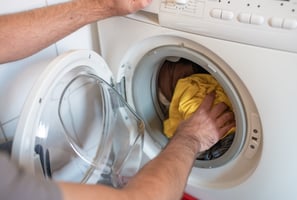In the previous article, we explained that Gore-Tex has high performance, but that this performance...
Maintenance of Gore-Tex (Water repellent treatment)
In the previous video, we explained that Gore-Tex has high performance, but that this performance cannot be utilized without maintenance. We also suggested that maintenance should be divided into two categories: daily maintenance and irregular maintenance.
In this article, we will explain in detail about the irregular maintenance of Gore-Tex, namely water-repellent treatment.
If Gore-Tex loses its water-repellent properties, it loses its performance
This is partly true, but also partly false.
The important functions of Gore-Tex fabric as an outdoor jacket are waterproofness, windproofness, and breathability. Of these, even if the water-repellent properties are lost, that is, even if the water stops being repelled and the fabric looks like it has soaked up water, the waterproof and windproof properties can still be maintained. Because the Gore-Tex membrane is sandwiched between the layers of fabric, even if water seeps into the outer layer of fabric, as long as there are no holes, there will be no water penetration.
On the other hand, if the water-repellent performance is lost, the moisture permeability is also lost. The significance of Gore-Tex is that it is waterproof and also has moisture permeability, which allows moisture to escape. If it did not have moisture permeability, there would be no difference between a rubber raincoat and a disposable plastic raincoat. In fact, it would even be a disadvantage, as the water retained in the fabric would make it heavier. Because it is Gore-Tex, maintaining its water-repellent performance is just as important as maintaining Gore-Tex's original performance.
When to treat Gore-Tex with water-repellent treatment
The water-repellent treatment does not need to be done every time you wash your clothes. As part of your daily care, the washing of Gore-Tex that we explained in the previous article is sufficient. However, as you use Gore-Tex, the surface will wear down and the coating that gives it its water-repellent properties will come off. In such a situation, no matter how many times you wash it and then dry it in a hot dryer, the coating will be lost and the water-repellent properties will not return. If the water-repellent properties do not return even after washing and heat-drying as explained in the previous article, it is time to have the water-repellent treatment for Gore-Tex applied.
The coating on Gore-Tex does not peel off over time. If you never use it at all, the performance will not deteriorate. It is only when you use it that the performance deteriorates.
How to waterproof your Gore-Tex
There are two ways to waterproof your Gore-Tex. You can either do it yourself, or you can have a professional do it for you. First, we'll explain how to waterproof your Gore-Tex yourself.
i) When performing the water-repellent treatment yourself
There are two ways you can perform the water-repellent treatment yourself. The first is to use a waterproof spray, and the second is to use a commercially available water-repellent agent.
i-i) When using a waterproof spray
Using a waterproof spray is the easiest way to perform the water-repellent treatment.
If you spray the waterproofing spray on your clothes when they are dry, to the point where the fabric is damp, the water-repellent function will be restored.
The important thing to remember is to spray the clothes outside, where you won't inhale the spray, and to spray in the direction of the wind.
While the water-repellent treatment using waterproofing spray is the easiest, the water-repellent performance is often the shortest-lasting. This is the best treatment for people who want to repel water for a short time, such as when commuting to work or school.
i-ii) Using a commercially available water-repellent agent
Using a commercially available water-repellent agent is more labor-intensive than using a waterproof spray.
First, wash the item in a washing machine as normal, then, while it is still wet, add the specified amount of the commercially available water-repellent agent instead of detergent, and wash it again. After that, wring out the water, hang it up to dry in the shade, and once the jacket is completely dry, heat-treat it in a dryer for about 20 minutes.
There are two points to be careful of at this stage. The first is not to add too much of the commercially available water-repellent agent. It is easy to think that adding more will help maintain the water-repellent performance, but unfortunately this is not the case, and it can even cause water-repellent stains.
Another point is the final heat treatment. The key is to put the jacket in the dryer only after it has completely dried out. If you put the jacket in the dryer before it has dried out completely, the energy used for evaporation will be used up, and the energy for activating the water-repellent agent will not be available.
ii) Another option is to have a professional do the maintenance for you
We offer professional cleaning and water-repellent treatment services for outdoor jackets, including Gore-Tex.
What is the difference between this and water-repellent treatment done by individuals? The water-repellent agent used is different, and we also use a machine to fix the water-repellent finish. And the water-repellent treatment is not just determined by the water-repellent process, as the pre-treatment also has an effect, so the washing method is also different. The process is similar to the process of applying water-repellent treatment yourself, with the steps being pre-treatment, water-repellent treatment, and fixing, but the treatment used in each process is very different.
For this reason, the water-repellent treatment carried out by professionals is of a high quality and can achieve a high level of durability.
On the other hand, there are also disadvantages, such as the fact that it is more expensive than applying water-repellent treatment yourself, and it also takes longer.
Summary
In this article, we have introduced the water-repellent treatment as a type of irregular maintenance for Gore-Tex. Rather than doing the water-repellent treatment every time you use your product, it is better to do it when the coating has peeled off and the water-repellent properties do not recover even after heat treatment.
There are two ways of doing the water-repellent treatment: doing it yourself or asking a professional to do it.
If you do the water-repellent treatment yourself, it's quick and cheap, but the water-repellent effect tends to wear off quickly. On the other hand, if you have a professional do the treatment, the water-repellent effect will last longer, but it's more expensive and takes longer.
I think it depends on the situation you're using it in, so I think it's best to use it according to your own tastes and preferences.



.jpg?height=200&name=vol03(1).jpg)